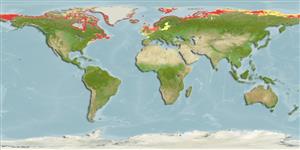Classification / Names
Common names from other countries
Issue
The species Salvelinus aureolus Bean, 1887 is considered as valid in Eschmeyer (CofF ver. May 2011: Ref. 86870) following Fuller et al. (1999: Ref. 87253). Treated as synonym of Salvelinus alpinus oquassa by Qadi (1974: Ref. 87252); and probably a synonym of Salvelinus alpinus
Main reference
Size / Weight / Age
Max length : 107 cm TL male/unsexed; (Ref. 40637); common length : 40.0 cm TL male/unsexed; (Ref. 4779); max. published weight: 15.0 kg (Ref. 4779); max. reported age: 40 years (Ref. 46974)
Length at first maturity
Lm 60.0 range ? - ? cm
Environment
Marine; freshwater; brackish; benthopelagic; anadromous (Ref. 51243); depth range 0 - 70 m (Ref. 30578), usually 0 - 1 m (Ref. 101587)
Climate / Range
Temperate; 4°C - 16°C (Ref. 2059), preferred ? (Ref. 107945); 85°N - 42°N, 180°W - 180°E
Distribution
Europe: northern Atlantic southward to southern Norway, also Iceland and southern Greenland. Isolated populations in Northern UK, Scandinavia, Finland and the Alps. North America: Landlocked populations in Quebec, Canada and in Maine and New Hampshire in USA (Ref. 7251).
Countries | FAO areas | Ecosystems | Occurrences | Introductions
Short description
Dorsal
spines
(total): 4 - 5;
Dorsal
soft rays
(total): 8-16;
Anal
spines: 3-4;
Anal
soft rays: 7 - 15;
Vertebrae: 62 - 68. Distinguished by the presence of 23 to 32 gill rakers, 37 to 75 pyloric caeca and, on the sides and back, pink to red spots, the largest of which are usually larger than the pupil of the eye (Ref. 27547). Lateral line curves slightly downward from the head (Ref. 27547). Pelvic fins with axillary process; caudal emarginate (Ref. 27547). Color highly variable, depending on location, time of year and degree of sexual development. In general, back is dark, usually rather brown but sometimes with a green cast; the sides are lighter, belly pale; sides and back are liberally sprinkled with pink to red spots, the largest spots along the lateral line usually larger than the pupil of the eye; forward edges of pectoral, pelvic and anal fins, and sometimes the caudal, with a narrow white margin; fins pale in young, dorsal and caudal dark in adults (Ref. 27547). Spawning adults, especially males, are brilliant orange-red to bright red on the ventral side and on the pectoral, pelvic and anal fins. Young have about 11 dark parr marks on each side (Ref. 27547). Caudal fin with 19 rays (Ref. 2196).
IUCN Red List Status (Ref. 115185)
Threat to humans
Harmless
Human uses
Fisheries: minor commercial; aquaculture: commercial; gamefish: yes
Tools
Special reports
Download XML
Internet sources
Estimates of some properties based on models
Phylogenetic diversity index
PD50 = 0.5000 many relatives (e.g. carps) 0.5 - 2.0 few relatives (e.g. lungfishes)
Trophic Level
4.4 ±0.5 se; Based on diet studies.
Resilience
Low, minimum population doubling time 4.5 - 14 years (tm=7-10; tmax=24; Fec=400)
Vulnerability
High to very high vulnerability (74 of 100)
Price category
